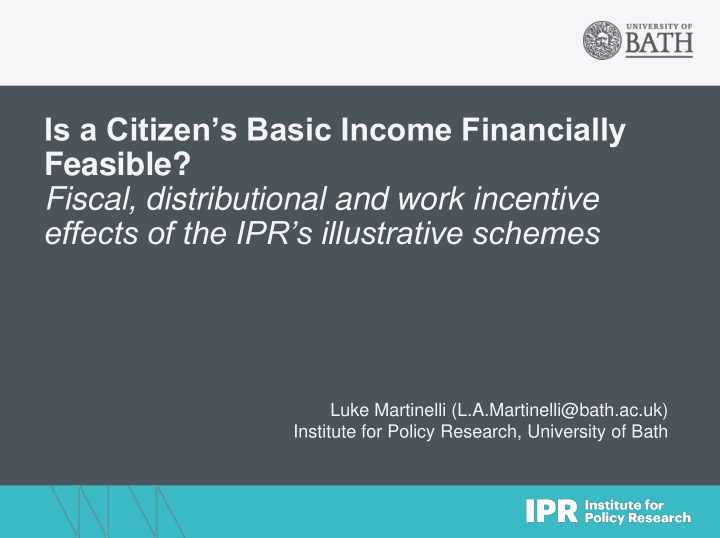



Is a Citizen’s Basic Income Financially Feasible? Fiscal, distributional and work incentive effects of the IPR’s illustrative schemes Luke Martinelli (L.A.Martinelli@bath.ac.uk) Institute for Policy Research, University of Bath
Outline • What we modelled and why • Fiscal and distributional effects • Implications for static work incentives • Some limitations of the microsimulation approach
The IPR’s models • ‘Full’ schemes paid at different levels relating to existing benefits • Full vs. partial basic income • Why? • Others have modelled partial / hybrid schemes (Reed and Lansley, 2016; Torry, 2016) • Full schemes retain range of advantages over partial schemes • Supplements to compensate for loss of disability premiums • Basic incomes for different age groups • Young people 18-25, Pensioners • Interested in: • Trade-offs between fiscal and distributional goals – affordability and adequacy • Static work incentives • Breakdown of effects by demographic – income level, labour market status, family type, disability, sex
Comparison of gross costs and distributional consequences Scheme Gross cost Tax / benefit changes and Change in (For comparison, total saving household poverty benefit spending in 2016-17 level was £210bn) Full scheme 1: £73.10 for £288bn Elimination of BSP, CA, CB, +3% working-age adults; £155.60 for CTC, ESA, IS, JSA, PC, pensioners; and £67.01 for and WTC plus PITA children £212bn Full scheme 2: as above plus £326bn As above -19% payments corresponding to £214bn standard disability supplements Full scheme 3: as 1 plus value £427bn As above -39% of personal income tax £217bn allowance (£42.19 per week) Young adult’s income £26bn Elimination of ESA, IS and -8% JSA for 18-25 £2bn Citizen’s pension £95bn Elimination of BSP and PC -3% £71bn
Distributional effects of revenue neutral full schemes • Changes to tax system • Eliminate personal income tax allowance and harmonise national insurance rates at 12% • Full scheme 1 requires increase of 4% across all tax bands • Full scheme 2 requires increase of 8% across all tax bands • Replacing complex benefit structure with modest uniform payments leads to poor households losing out • Full scheme 1: increases in poverty and inequality rates (+10% and +4%); majority of single-headed and workless households lose income • Full scheme 2: reduction in poverty and inequality rates (-7% and -5.5%) but still large numbers of poorer households lose out (20% of the poorest quintile become poorer)
Work incentive effects • Participation tax rate is a static measures of the financial incentive to work vs. receiving benefit – how much gross income is taxed away? • PTR falls on average for bottom three income quintiles for full scheme 1 • PTR falls by an average of 17% for households receiving means- tested benefits • However majority of workers face deteriorating work incentives due to higher tax rates • 70% of second earners • 67-74% of dual earner households
Potential limitations of microsimulation approach • Behavioural change • Labour supply response highly ambiguous • IFS (2017) on uncertainty of taxpayer response • Other funding options than personal income taxes • No account for strengths of basic income in relation to • Precarious / fluctuating employment patterns • Stigma and other psychological effects of conditionality • Non-take-up
Conclusions • Dilemma: full schemes that are affordable are inadequate, those that are adequate are unaffordable • Affordable = sustainable financing arrangements • High tax rates = political challenge and possible contractions in labour supply = unsustainable? • Labour market effects of basic income are unclear • Generalised effects of higher tax rates against improvement of work incentives for lower income households and benefit recipients • Partial schemes are likely to fare better but do not carry same advantages: simplicity, enhanced work incentives, freedom from conditionality, etc. • Three-way trade-off between meeting need, controlling cost, and retaining advantages of universalism
More details: • The Fiscal and Distributional Implications of Alternative Universal Basic Income Schemes in the UK • Exploring the Distributional and Work Incentive Effects of Plausible Illustrative Basic Income Schemes • IPR Policy Brief: Assessing the Case for a Universal Basic Income in the UK
Recommend
More recommend